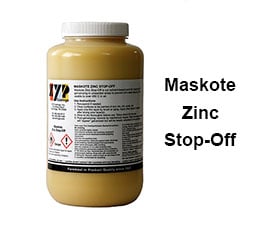Maskote Zinc Stop-Off
Factors
Some Things to Know
The performance of all steel coatings relies on proper surface preparation. Maskote Zinc Stop-Off is a durable solvent-based coating that will perform well under adverse conditions, however some attention to substrate and galvanizing conditions can result in improved performance.
Surface
Steel surface should be free of any impediments such as rust, as well as any oils, films or solvents left from the fabrication processes. Many solvents, including Saw Cut, Mineral Spirits, water based cutting oils, etc., leave a film of their own which may interfere with the coating adhering to the steel.
- Brush, wipe or wire wheel away any rust, flaking or debris.
- Wipe the area to be coated clean with a rag soaked with MEK (Methyl Ethyl Ketone). In the case of threaded areas, a bristled brush soaked in MEK may be used to assure the thread cavities are thoroughly clean.
Type of Steel
Maskote is proven successful on many grades and types of hot rolled carbon steel. If the steel involved is a unique alloy the fabricator should consider testing a piece to determine compatibility.
Temperature
As with all coatings extreme low temperatures will delay the curing time and this could affect performance.
Substrate Thickness (Mass)
The thickness of the steel being galvanized will effect the Hot Dip Galvanizing process. When steel is hot dip galvanized it is immersed in molten zinc. The immersion time is relative to the body of steel. Ideally the steel stays in the zinc until it reaches ambient temperature, approximately 840°F / 449°C. Once it is removed the larger the mass of steel, the longer it will take to cool down. Just as an example 1/2" diameter anchor bolts may cool to the touch in 10 minutes. 2" diameter anchor bolts may take one hour to cool to the same temperature.
This will not stop Maskote from delivering positive results however the fabricator may find removal easier if the thickness of the coating is increased, or possibly two coats are applied in some cases.




